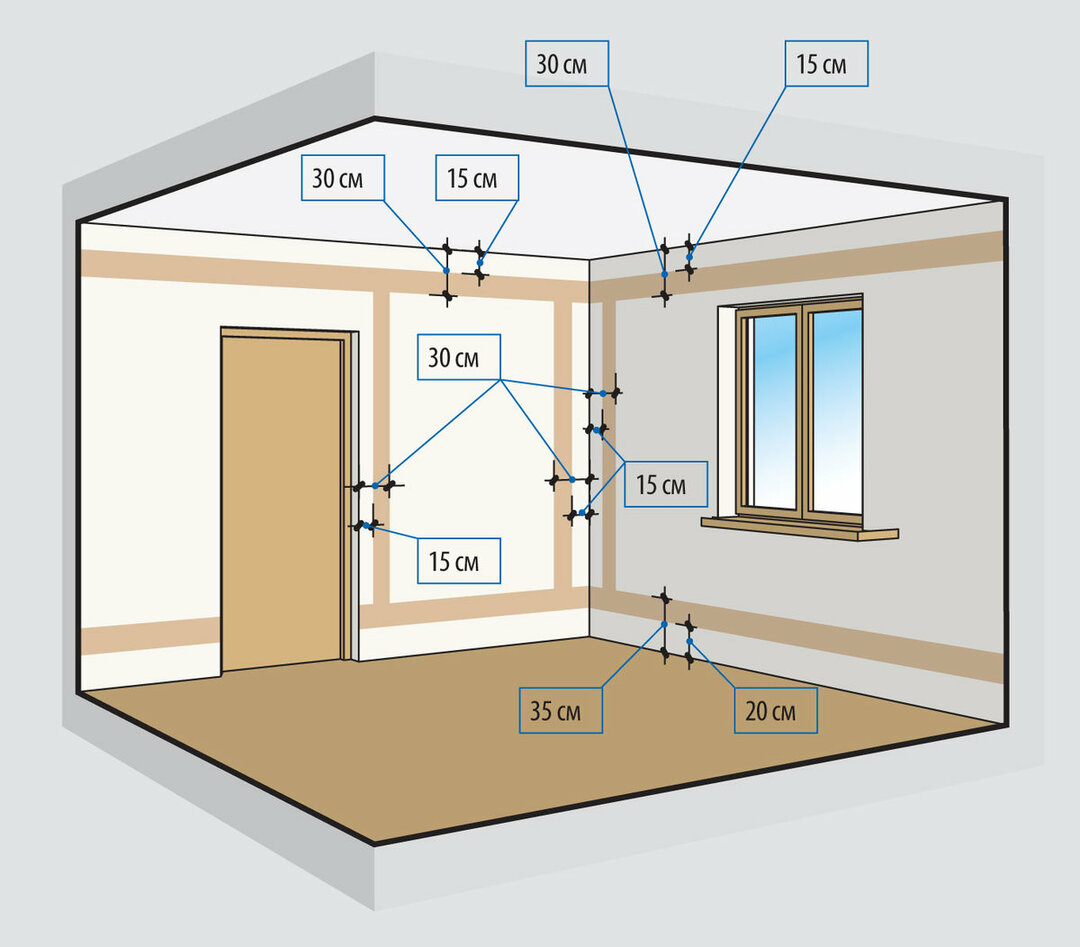How the electric cables are laid, we recommend reading the second section of OES 6. The “outdated” version. The provisions listed in the document are advisory in nature. Fulfilling electrical wiring requirements will most likely avoid violations. The information is presented within one document, it remains to read. Let's see how power electrical cables are laid.
How and where to lay the cable

Cables
Look first at the end of the OES 6, dispelling doubts. The endless list of approval will convince the readers: a real document appeared before you, seen by many builders, officials. Able to appear new requirements, but later.ПУЭ 6 electric lines classifies:
- The first part considers the types of electrical wiring, choice, typical conditions: premises, street, attic.
- Lines with voltage below 35 kW( separately before / after 1 kV).
- Lines with voltage below 220 kV( including cables up to 35 kV).
- Overhead cable lines( to / above 1 kV).
The first negotiates the EMP 6( Section 2) scope. The following requirements must be met for cables with a cross section of phase conductors up to 16 square millimeters. Unfortunately, omitted copper or aluminum. We conclude: it is always good until the opposite is proved. We first consider the classification of electrical wiring:
- By the nature of the occurrence:
- Open. It happens stationary, portable, mobile. It is laid in the open air along the surfaces of structures, between the supports. Along the way, insulators, rollers, pipes, boxes, sleeves, baseboards, poles are used.
- Locked. It is laid inside the walls: hidden by plaster, gates, inside the concrete( walls, floor, ceiling) in monolith, using cavities.
- External electrical wiring is laid on external walls. The length in limbo is no more than 100 meters( four spans of 25 meters each).Others concern overhead lines, underground routes.
Allowed to lay electrical cable in the bathroom floor. Another question relates to the protective measures envisaged( grounded grid).The case is limited to trifles.

. The principle of power transmission.
. Wiring inside buildings.
. Among the general requirements, the inadmissibility of laying near voltage circuits to / above 42 volts with rare exceptions is indicated( see clause 2.1.16).Actually today's reality, when I wanted to light without restraint the bathroom with a constant 12 volts. Fortunately adapter for DIN-rail is sold for 800 rubles. It turns out that it is forbidden to merge with one branch. Do house wiring from 12 volts. Safe, allows the use of a minimum cross-section of the wiring.
ПУЭ 6 here gives the answer: use fireproof dividing partitions between the wires. Much more curious will seem the requirement of joint following phase, zero( reverse) wires( it is forbidden to use adjacent pipes).Residents of the village should know: the cable is not laid in combustible cavities, niches of wooden walls. Ceramic rollers-insulators are used( the distance to the plane is more than 10 mm, or by enclosing non-combustible material).
When open, the distance from the floor is at least 2.5 meters. We believe that in private houses by villagers the requirement is not met. Only for rooms with increased danger. It is not obliged to reduce the voltage by fitting the 42 volts to the upper limit, placing the electrical cable for the internal installation at a height of two meters. But it is possible to do. Remember the adapter 12 volts, put in the switchboard. For illumination purposes, just enough to provide a village house. As for sockets, you should use a protected cable( cable channels).When the protection level of the box is IP20 and higher, the height is not standardized. Connections are allowed in the form:
- crimp;
- terminal blocks;
- welding;
- soldering.

Cabling in the house
By the way, bare twisting is prohibited even for ground circuits. Insulation of joints is not worse than linear sections. Further, there are obvious requirements: the lack of tension, the availability of nodes, connections( service specialists).A cable protected against burning should be laid under the cladding: many installers have forgotten it. Yutub will give you as many plots as you like: facing PVC panels hides the traditional PVA for several lived. The mentioned part of the OLC is inactive, the installation process itself does not become less dangerous. The conclusions are clear: we are doing for ourselves( so that nothing happens to be guaranteed).
Thus, laying an electric cable in a wooden house is drawn by fine art. Useful aluminum corrugation. Clearly, plastic is not always suitable for reasons of lack of fire. Be comforted: aluminum corrugation is easy to ground, certainly improving the electromagnetic environment at home, simplify the replacement of wiring, save against fire. Like other metal parts of the building, the sleeves, pipes, cable channels disappear. Able to serve as a screen. Read more standards laying electrical cable, see table.2.1.3 PUE 6, according to the peculiarities of laying in different climatic conditions( heat, dampness) many rules are spelled out in section 2.1.
Increased attention is paid to intersections with pipelines. The electric cable is being laid, leaving a gap of at least 5 cm. If the water in the pipeline is hot or something flammable( read gas), the distance doubles. Moreover, each side of the intersection should be protected by 25 cm against mechanical damage. On a parallel line from the pipeline, cable, the distance is taken 10 or 40 cm minimum depending on the content( gas, kerosene, hot water, steam).

External wiring of the building
Rules for laying outdoor wiring
Finally, what is surprising is the color marking of the electric cable for outdoor installation from the substation:
- Yellow - phase A.
- Green - phase B.
- Red - phase C.
- Blue - zero working wire.
- With strips of yellow and green color - a zero protective wire.
- Backup tire is marked with transverse strips to the main.
The colors differ from the PVA cables( some), which are not intended to draw three-phase lines. Laying of electrical cable in the ground in the country is carried out by other types. Marking of pipes is in accordance with GOST R IEC 61386.24, examples of cables will be prompted by GOST 16442. The last document will indicate which brand of electric cable is not suitable for laying in the ground. The subtleties of installation are indicated by the ПУЭ 6, starting from item 2.3.83.It is said, the cable line lies to the surface no closer than 0.7 meters. Filling is performed from below( sand, crushed stone), from above it is covered slightly with soil, free from various kinds of garbage.
Selection of wiring cross-section( cable cores)
According to PUE 6, the cable is divided into two categories of conductor cross-sections:
- Within 6 square millimeters of copper, 10 of aluminum is selected from tables 1.3.4 and 1.3.5 directly. As for the long mode of operation.
- Otherwise, when the core thickness is higher, multiply the tabulated current by the correction factor 0.875 / √ TPV.Where TPV - the relative duration of the activity of the equipment in the operating cycle. In other words, the equipment works less over a period of time, it is thinner to take a vein.
Please note that the numbers shown in the table are widely quoted by the literature without indicating the source. PUE 6 says: the maximum continuous current of the core is determined by the type of cable( the number of conductors in the insulation), the bookmarking method discussed above. By grouping the data, readers will easily choose an electrical cable for laying by air, underground. It's nice that the parameters are graded according to the type of insulation, voltage. There is no volume to call information exhaustive, some of which are removed from official circulation from current legislation.
It has become difficult to find requirements for the cross section of the neutral conductor of a three-phase network cable. PUE 6 directly says: it must be at least 50% of the phase, sometimes it increases to 100%.Correction factors for the choice of current limit depending on the ambient temperature will seem useful. You will see that, depending on the conditions, the cable section can be reduced, or, on the contrary, it will have to be increased. Correction factors are introduced for soil type. It is important for those wishing to properly pave the track.
Readers will like the table 2.1.1, indicating the smallest cross-section of the lived copper and aluminum. When stationary cabling on rollers indoors, the value is at least 1 square millimeter of copper. The current can reach 17 A( PVA cords with PVC insulation), approximately 3.7 kW of power. I wanted to connect the LED lamps with a thinner section - it’s impossible. We assume that the OuI 6 was released long before the home versions of the sources in our area appeared. Surely the engineers will have to revise the measurements, amend the kind of light bulbs.
Cable blocks
The permissible current of cable blocks depending on the structure is widely discussed. The laying process is described in section 2.3( now removed).It is said that cast iron, concrete, asbestos-cement pipes are suitable for the cable block. The calculation of the number of channels, structuring is carried out in accordance with clause 1.3.20, and 15%( at least 1 piece) is allocated for a reserve( in case there is a need for laying an additional line).
The depth of the cable units is selected in accordance with clause 2.3.84.In most cases, it is 0.7 - 1 meter. There are assumptions to reduce the distance to half a meter on the length of the site no more than 5 meters. Allows you to properly lay the channels, which should have a slope of 0.2% towards the wells( depth increases).When laying we take into account: the minimum distance between the lines is determined by the voltage that increases with increasing.
The definition of cable blocks is hushed up, so readers probably have grown a question the size of a mountain. Meanwhile, the structures are formed by channels of various kinds connecting the wells. Due to the structure, the underground laying of electrical cable is carried out without the involvement of construction equipment. The main thing is that there is no need to open expensive coatings. Fighting, under the Piazza is used something like cable channels.
A similar technology helps cable laying under the riverbed. A special unit drills an arc-shaped tunnel in the ground overlooking the opposite bank. Inside the cable is laid. If necessary, the wall, of course, reinforced. Gives the opportunity in the future to freely repair a part of the route, change certain conductors( add, replace, remove).It is clear that underwater types of cabling are inaccessible to the majority of private traders, you need to know in case you need to go through a difficult section.
Conclusion
We remind you that the ELP 6 indicated is “out of date”.It is still permissible to be guided while conducting work. Similarly, the laying of electrical cable in the apartment is carried out according to documents, marked by the confidence of professionals.


